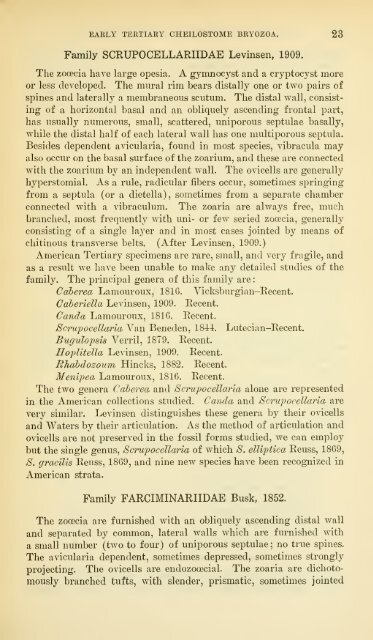Bulletin - United States National Museum - Smithsonian Institution
Bulletin - United States National Museum - Smithsonian Institution
Bulletin - United States National Museum - Smithsonian Institution
Create successful ePaper yourself
Turn your PDF publications into a flip-book with our unique Google optimized e-Paper software.
EARLY TERTIAEY CHEILOSTOME BRYOZOA. 23<br />
Family SCRUPOCELLARIIDAE Levinsen, 1909.<br />
The zooecia have large opesia. A gymnocyst and a cryptocyst more<br />
or less developed. The mural rim bears distally one or two pairs of<br />
spines and laterally a membraneous scutum. The distal wall, consist-<br />
ing of a horizontal basal and an obliquely ascending frontal part,<br />
has usually numerous, small, scattered, uniporous septulae basally,<br />
while the distal half of each lateral wall has one multiporous septula.<br />
Besides dependent avicularia, found in most species, vibracula may<br />
also occur on the basal surface of the zoarium, and these are connected<br />
with the zoarium by an independent wall. The ovicells are generally<br />
hyperstomial. As a rule, radicular fibers occur, sometimes springing<br />
from a septula (or a dietella), sometimes from a separate chamber<br />
connected with a vibraculum. The zoaria are always free, much<br />
branched, most frequently with uni- or few seried zooecia, generally<br />
consisting of a single laj'er and in most cases jointed by means of<br />
chitinous transverse belts. (After Levinsen, 1909.)<br />
American Tertiary specimens are rare, small, and very fragile, and<br />
as a result we have been unable to make any detailed studies of the<br />
family. The principal genera of this family are<br />
Cdberea Lamouroux, 1816. Vicksburgian-Recent.<br />
Caheriella Levinsen, 1909. Recent.<br />
Canda Lamouroux, 1816. Recent.<br />
Scrujyocellarla Van Beneden, 1844. Lutecian-Recent.<br />
Bugulopsis Verril, 1879. Recent.<br />
Hoplitella Levinsen, 1909. Recent.<br />
RJiahdozoum Hincks, 1882. Recent.<br />
Menipea Lamouroux, 1816. Recent.<br />
The two genera Cohered and Scnipocellar'ia alone are represented<br />
in the American collections studied. Canda and Scrupocellaria are<br />
very similar. Levinsen distinguishes these genera by their ovicells<br />
and Waters by their articulation. Ks the method of articulation and<br />
ovicells are not preserved in the fossil forms studied, we can employ<br />
but the single genus, Scrupocellaria of which S. elliptica Reuss, 1869,<br />
S. gracilis Reuss, 1869, and nine new species have been recognized in<br />
American strata.<br />
Family FARCIMINARIIDAE Busk, 1852.<br />
The zocecia are furnished with an obliquely ascending distal wall<br />
and separated by common, lateral walls which are furnished with<br />
a small number (two to four) of uniporous septulae; no true spines.<br />
The avicularia dependent, sometimes depressed, sometimes strongly<br />
projecting. The ovicells are endozooecial. The zoaria are dichotomously<br />
branched tufts, with slender, prismatic, sometimes jointed<br />
:

















